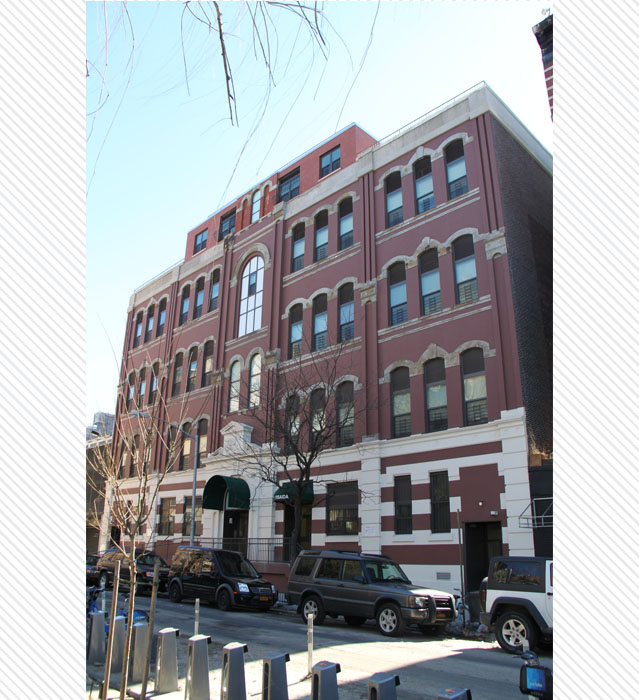- Home
- East Village Block Finder
- Guided Tours
- African American History
- Astor Tenements
- CBJ Snyder Schools
- Churches
- Dry Dock District Tour
- Historic East 10th Street
- Individual Landmarks
- Kleindeutschland
- LGBTQ Sites
- Little Ukraine
- Loisaida Tour
- Music Venues
- Off-Off Broadway Theatres
- Places that Matter
- Punk Rock
- Squats of the East Village
- Synagogues
- Yiddish Rialto
- Glossary
710 East 9th Street | Block : 378 | Lot #10
- Building Date : 1876
- Original Use : Institutional
- Original Owner : City of New York Board of Education
- Original Architect : D. I. Stagg
Description & Building Alterations
This former H-plan school building was constructed in 1876 to the designs of D. I. Stagg for the Board of Education. It was originally known as Grammar School No. 36, and on later maps it is referred to as Public School No. 36. An 1884 source found on Google Books (see sidebar) reveals that the school was divided into a boys’ department, a girls’ department, and a primary department at that time. It continued to serve as a public school until the 1970s.
Beginning in the mid-1970s, the local development corporation Losaida, Inc., was established here. According to the group’s website, it began as a grassroots movement led by Puerto Rican activists and Hispanic residents of the neighborhood to combat the effects of rampant violence, drugs, gangs, and poverty facing local children, youth and families. The organization was formally incorporated in 1978 with the mission of addressing the serious economic and social disenfranchisement of poor and low-income Latinx residents, with employment and training opportunities, comprehensive youth development initiatives, as well as neighborhood revitalization activities that positively highlighted the rich culture, heritage, and contribution of the Puerto Rican and Latin American community in this City.
It has not always been smooth sailing for the grassroots organization. In 2008, they faced eviction from their city-owned building, which was to be sold for development. The community rallied around Loisaida, Inc., however, and they were allowed to stay.
Since 1987, they have run the Loisaida Festival, along with a wealth of programs in education, arts, culture, and community development. In the face of a rapidly gentrifying neighborhood, they say their mission remains to address the serious economic and social disenfranchisement of poor and low-income Latinx residents, with employment and training opportunities, comprehensive youth development initiatives, and neighborhood revitalization activities that positively highlight the rich culture, heritage, and contribution of the Puerto Rican and Latin American community. The organization focuses on affordable education opportunities in cultural fields, S.T.E.A.M. (Science, Technology, Engineering, Arts and Mathematics), and design. They endeavor to celebrate the grassroots invention and immigrant spirit of the Loisaida neighborhood and Latinx cultural vitality and contributions to New York City.
An official street sign even went up in 1987 on Avenue C between 14th and Houston Streets co-naming the Avenue Loisaida Avenue.
The building is four stories in height and features a five-story central entrance bay with “1876” inscribed over the doorway. It is also present on the 1868 Perris & Browne fire insurance map, but this is because the map-makers later updated the map to include it (a typical practice in the era of hand-drawn maps). By 1916, three one-story additions were built on the lot, but they are not visible from the street. The building is now missing its cornice. As the Superintendent of School Buildings, D. I. Stagg designed a number of other schools for the Board of Education. He was responsible for P.S. 7 (built 1886) at 272 West 10th Street, which is now known as the Village Community School and is located within the Greenwich Village Historic District Extension I. In 2011-2012, an extra story was partially added to the roof of the building.
Before the construction of this building in 1876, another school owned by the Board of Education existed on this lot. Tax assessment records indicate that this rectangular building was built in 1848 as Ward School No. 21 (it is visible on the 1852 Perris & Browne map). By the late 1850s/early 1860s, the front of the building was widened so that its plan was T-shaped. The school was then known as Common School No. 36. Even though that building was demolished, the existence of a school on this lot since the 1840s serves as a remarkable connection to the neighborhood’s earliest period of development when it was known as the Dry Dock district. As is evident in the 1852 map, this section of the East Village was surrounded by iron yards, saw mills, ship yards, and other manufacturing businesses before transforming into the neighborhood we see today.
Block : 378 / Lot : 010 / Building Date : 1876 / Original Owner : City of New York Board of Education / Original Use : Institutional / Original Architect : D. I. Stagg


Do you know this building? Please share your own stories or photos of this building here!